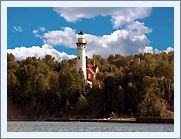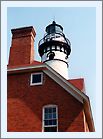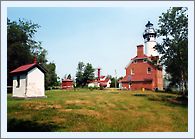|
Historical Information

With the extension of the Lake Superior and Mississippi Railroad
into Duluth in the late 1860's, the harbor quickly assumed the role of
the major shipping point for the bounty of America's bread basket to the
west. Wharves, harbors, piers and elevators sprang up around the growing
harbor to handle the incoming train loads or grain to be loaded on
awaiting vessels for shipment through the Soo Locks to the hungry cities
of the lower lakes. Standing directly in the straight-line path between
Duluth and the northern tip of the Keweenaw, the Apostle Islands
represented a significant threat to mariners navigating across Superior.
With Outer Island the most northeasterly of the group, the island
quickly assumed an important role as the turning point for both up and
downbound vessels. However, with Outer Island Shoal lying a mile and a
half to the north of the island, captains had to take care to give the
island sufficient berth, or chance ripping their hulls on the rocky
bottom lurking a mere ten feet beneath the surface.
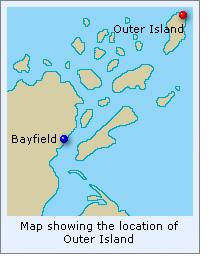 Taking
up the cause of maritime interests on April 4, 1869, acting Senate
President Pro Tempore Benjamin Franklin Wade of Ohio presented a
memorial on behalf of the Wisconsin State Legislature praying for an
appropriation for the construction of lighthouses to mark Outer Island.
The matter was referred to the Committee on Commerce for further
investigation, and while the Lighthouse Board repeated the plea for the
station's construction in its 1871 and 1872 annual reports, no movement
was forthcoming until March 3, 1871, when an appropriation of $40,000
was finally made for the station's construction. Taking
up the cause of maritime interests on April 4, 1869, acting Senate
President Pro Tempore Benjamin Franklin Wade of Ohio presented a
memorial on behalf of the Wisconsin State Legislature praying for an
appropriation for the construction of lighthouses to mark Outer Island.
The matter was referred to the Committee on Commerce for further
investigation, and while the Lighthouse Board repeated the plea for the
station's construction in its 1871 and 1872 annual reports, no movement
was forthcoming until March 3, 1871, when an appropriation of $40,000
was finally made for the station's construction.
Responsibility for the design of
station buildings was that of Eleventh District Engineer, Brevet
Brigadier General Orlando M.
Poe. Prior to this point, the designs for Eleventh District
Lights had been largely utilitarian, of basic "shoe box"
design with little ornamentation or thought as to the quality of life
for the station's keepers. Poe's design for the Outer Island Light was
unique, in that it was designed not only to be thoroughly appropriate
for the need, but also included design elements normally reserved for
major public buildings and stately homes. Poe's plans for the station
called for a cut stone foundation supporting an 80-foot brick tower
gracefully tapering from its base to the gallery, which was supported by
a series of 16 ornate corbels. Immediately below the gallery, a
watchroom was incorporated into the tower, and featured four arch-topped
windows surmounted by matching curved stone pediments. The three-story
brick dwelling was to be built over a full basement, and featured a
gable roof with partial hips at each end. To provide the keepers with
shelter during their numerous nightly trips to the tower to tend the
light, it was connected to the tower by means of an enclosed
timber-framed passage. A spiral cast iron stairway would its way up the
inside of the tower to end in a circular service room at the gallery
level, atop which was placed a decagonal cast iron lantern. A narrower
gallery encircled the lantern itself to provide a platform from which
keepers could clean the storm panels. As witness to the strategic
importance placed upon this station, plans called for the lantern to be
outfitted with a flashing white Third
Order Fresnel lens.
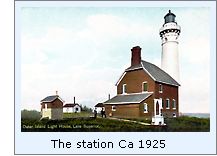 The site for the station was selected
atop a forty-foot red clay bluff, which it was calculated would provide
the lens with a focal plane of 130 feet, allowing the light to be seen
distance of 19 ¼ miles in clear weather. Work at the site began in
August 1873, and continued until the end of that year's season of
navigation, when the arrival of winter made working conditions on the
island untenable. The crew returned the following spring, and work
continued throughout the summer and into the fall. Surprisingly, two
"greenhorns" with no previous light keeping experience were
appointed to staff this important new Light, with Orator K. Hall chosen
as Acting Keeper and John Drouillard his acting First Assistant.
Construction was completed in October, and Hall and Drouillard exhibited
the new Outer Island Light for the first time on the night of October 3,
1874. The site for the station was selected
atop a forty-foot red clay bluff, which it was calculated would provide
the lens with a focal plane of 130 feet, allowing the light to be seen
distance of 19 ¼ miles in clear weather. Work at the site began in
August 1873, and continued until the end of that year's season of
navigation, when the arrival of winter made working conditions on the
island untenable. The crew returned the following spring, and work
continued throughout the summer and into the fall. Surprisingly, two
"greenhorns" with no previous light keeping experience were
appointed to staff this important new Light, with Orator K. Hall chosen
as Acting Keeper and John Drouillard his acting First Assistant.
Construction was completed in October, and Hall and Drouillard exhibited
the new Outer Island Light for the first time on the night of October 3,
1874.
 Evidently, acting Assistant Keeper
Drullard was not cut out for the rigors of such isolated service, since
he resigned from lighthouse service on April 27, 1875, to be replaced by
Peter Ivory. Also that same year, a work crew returned to Outer Island
to construct a fog signal building a short distance to the northwest of
the tower, in which a single 10-inch steam powered fog whistle and
boiler were installed. It is atypical that only one whistle was
installed, since they were usually installed in pairs to ensure that a
redundant unit was available in case the other was broken or needed to
be taken down for repair. The whistle was set up to emit a
characteristic repeated 60-second cycle consisting of a blast of 8
seconds followed by 52 seconds of silence. Whether as a result of the
increase in workload represented by the addition of the fog signal, or
whether he too was unsuited for the work, acting Keeper Hall was removed
from the position on October 5th to be replaced by Henry Kuchli. Evidently, acting Assistant Keeper
Drullard was not cut out for the rigors of such isolated service, since
he resigned from lighthouse service on April 27, 1875, to be replaced by
Peter Ivory. Also that same year, a work crew returned to Outer Island
to construct a fog signal building a short distance to the northwest of
the tower, in which a single 10-inch steam powered fog whistle and
boiler were installed. It is atypical that only one whistle was
installed, since they were usually installed in pairs to ensure that a
redundant unit was available in case the other was broken or needed to
be taken down for repair. The whistle was set up to emit a
characteristic repeated 60-second cycle consisting of a blast of 8
seconds followed by 52 seconds of silence. Whether as a result of the
increase in workload represented by the addition of the fog signal, or
whether he too was unsuited for the work, acting Keeper Hall was removed
from the position on October 5th to be replaced by Henry Kuchli.
 After the construction of a second
steam signal building with a backup 10-inch steam whistle in 1875, life
at the island remained relatively uneventful until 1882 when it became
evident that the bluff in front of the station was eroding
significantly, and a crew arrived at the station to work on building a
revetment at the foot of the cliff in an attempt to stem increasing
erosion. Understandably, the Outer Island keepers tired of having to
carry all their supplies and coal for the fog signal boilers from the
visiting lighthouse tender up the stairs to the station, and they were
no doubt happy when a 242-foot long hand winch-powered tramway was
installed up the face of the bluff in 1884. The tramway was improved
further three years later, when a building housing a steam-powered
hoisting engine was erected at the top of the tramway, eliminating much
of the labor involved in taking-on supplies. After the construction of a second
steam signal building with a backup 10-inch steam whistle in 1875, life
at the island remained relatively uneventful until 1882 when it became
evident that the bluff in front of the station was eroding
significantly, and a crew arrived at the station to work on building a
revetment at the foot of the cliff in an attempt to stem increasing
erosion. Understandably, the Outer Island keepers tired of having to
carry all their supplies and coal for the fog signal boilers from the
visiting lighthouse tender up the stairs to the station, and they were
no doubt happy when a 242-foot long hand winch-powered tramway was
installed up the face of the bluff in 1884. The tramway was improved
further three years later, when a building housing a steam-powered
hoisting engine was erected at the top of the tramway, eliminating much
of the labor involved in taking-on supplies.
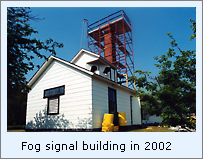 The tramway received considerable
repair in 1894, and was extended an additional 85 feet to allow the car
to service both fog signal buildings directly. Also at this time, new
brick foundations were installed beneath both fog signal buildings and
the tramway engine house and a new hoisting engine was installed. Prior
to the 1890's all fuel for the lamps was stored in a room in the cellar
beneath the keepers dwelling. As part of a system-wide upgrade resulting
from a devastating fuel fire, 1895 saw the construction of a standard
brick oil storage house some sixty feet to the southwest of the
dwelling. Outfitted with an iron roof, door and shelving, this building
was specifically designed to minimize the possibility of a spreading oil
fire. Also during this year, the Outer Island keepers were kept busy
shoveling 26 tons of coal into the fog signal boilers to keep the
whistles screaming a station-high 478 hours. The tramway received considerable
repair in 1894, and was extended an additional 85 feet to allow the car
to service both fog signal buildings directly. Also at this time, new
brick foundations were installed beneath both fog signal buildings and
the tramway engine house and a new hoisting engine was installed. Prior
to the 1890's all fuel for the lamps was stored in a room in the cellar
beneath the keepers dwelling. As part of a system-wide upgrade resulting
from a devastating fuel fire, 1895 saw the construction of a standard
brick oil storage house some sixty feet to the southwest of the
dwelling. Outfitted with an iron roof, door and shelving, this building
was specifically designed to minimize the possibility of a spreading oil
fire. Also during this year, the Outer Island keepers were kept busy
shoveling 26 tons of coal into the fog signal boilers to keep the
whistles screaming a station-high 478 hours.
 The lighthouse tender AMARANTH
arrived at the island late in 1900 and delivered materials for a number
of planned upgrades to the station. However, arriving as she did so late
in the season of navigation, the materials were merely unloaded and
stored on the station grounds until work could begin the following year.
When the work party arrived the following spring, their first order of
business was the combining of both fog signals into a single building.
Fog signal number 2 was taken down and moved close to the east side of
building 1, and the two were connected. The boiler and piping for signal
1 were replaced, and the entire plant was re-plumbed and overhauled. The
boat landing was rebuilt and filled with stone, and the section of the
tramway from the top of the bluff to the new fog signal building was
rebuilt. The lighthouse tender AMARANTH
arrived at the island late in 1900 and delivered materials for a number
of planned upgrades to the station. However, arriving as she did so late
in the season of navigation, the materials were merely unloaded and
stored on the station grounds until work could begin the following year.
When the work party arrived the following spring, their first order of
business was the combining of both fog signals into a single building.
Fog signal number 2 was taken down and moved close to the east side of
building 1, and the two were connected. The boiler and piping for signal
1 were replaced, and the entire plant was re-plumbed and overhauled. The
boat landing was rebuilt and filled with stone, and the section of the
tramway from the top of the bluff to the new fog signal building was
rebuilt.
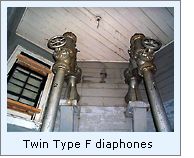 On September 28, 1905, a gale with 90
mile an hour winds whipped the water into one of the worst storms in
memory. When the gale subsided it was found that a total of 30 vessels
had been wrecked with 78 seamen losing their lives. During the height of
the storm, the steamer VENEZUELA with the 337-foot 3-masted
schooner-barge PRETORIA in the tow were passing off Outer Island. The
tow rope snapped in the seas, and the VENEZUELA drifted out of control
until her anchor took hold a mile and a half off the island. Her ten
crew members managed to board a life boat and began rowing toward the
island's shore. However, a huge wave flipped the life boat before it
could make the island, and five of the crew members perished. , The
remaining five crew members were saved by the Outer Island lighthouse
crew, consisting of Keeper John Irvine, First Assistant Thomas E. Irvine
and Second Assistant Otto Olson. On September 28, 1905, a gale with 90
mile an hour winds whipped the water into one of the worst storms in
memory. When the gale subsided it was found that a total of 30 vessels
had been wrecked with 78 seamen losing their lives. During the height of
the storm, the steamer VENEZUELA with the 337-foot 3-masted
schooner-barge PRETORIA in the tow were passing off Outer Island. The
tow rope snapped in the seas, and the VENEZUELA drifted out of control
until her anchor took hold a mile and a half off the island. Her ten
crew members managed to board a life boat and began rowing toward the
island's shore. However, a huge wave flipped the life boat before it
could make the island, and five of the crew members perished. , The
remaining five crew members were saved by the Outer Island lighthouse
crew, consisting of Keeper John Irvine, First Assistant Thomas E. Irvine
and Second Assistant Otto Olson.
 As a result of advancements being made
in illuminating technology, the stations lamp was changed from oil/wick
to incandescent oil vapor on June 5, 1913. Consisting of a pressurized
system in which vaporized kerosene was burned on a mantle similar to the
technology used in present day Coleman lanterns, the intensity of the
light was thus increased from 18,000 to 110,000 candlepower. Also at
this time, the characteristic of the light was changed to flashing white
with a repeated 50 second cycle consisting of a 4.7 second flash
followed by an eclipse of 10.3 seconds. As a result of advancements being made
in illuminating technology, the stations lamp was changed from oil/wick
to incandescent oil vapor on June 5, 1913. Consisting of a pressurized
system in which vaporized kerosene was burned on a mantle similar to the
technology used in present day Coleman lanterns, the intensity of the
light was thus increased from 18,000 to 110,000 candlepower. Also at
this time, the characteristic of the light was changed to flashing white
with a repeated 50 second cycle consisting of a 4.7 second flash
followed by an eclipse of 10.3 seconds.
1929 saw the replacement of the steam
powered 10-inch whistles with a pair of Type
F diaphone fog signals. Powered by air compressors driven by
diesel engines, these improved signals were not only significantly
louder than the old steam-powered whistles, but could be sounded
immediately when needed, without having to wait for boilers to build up
a head of steam.
 The station was electrified in 1940,
and the intensity of light increased to 140,000 candlepower. Finally,
1961 saw the automation of the station with the removal of the Fresnel
lens and the placement of a modern solar-powered 12-volt DC optic. No
longer needed to tend the light, keeper Theodore Schelvan left the
station for the last time after having served the station faithfully
since April 15. 1948. With the structures boarded-up, necessary
infrequent maintenance to the station's illuminating apparatus was
accomplished by the Coast Guard crew stationed out of Devils Island,
which remained as the last manned Apostle Island Light Station until
1978. The station was electrified in 1940,
and the intensity of light increased to 140,000 candlepower. Finally,
1961 saw the automation of the station with the removal of the Fresnel
lens and the placement of a modern solar-powered 12-volt DC optic. No
longer needed to tend the light, keeper Theodore Schelvan left the
station for the last time after having served the station faithfully
since April 15. 1948. With the structures boarded-up, necessary
infrequent maintenance to the station's illuminating apparatus was
accomplished by the Coast Guard crew stationed out of Devils Island,
which remained as the last manned Apostle Island Light Station until
1978.
The erosion of the cliff in front of
the lighthouse first mentioned in 1882 continues to represent a
significant problem at Outer Island. Between 1987 and 1881 the island
suffered its highest rate of erosion on record, averaging a loss of one
foot of bank per year. Today, the crest of the cliff is a mere 50 feet
from the lighthouse and fog signal building.
 The automated light in the tower
installed in 1961 was upgraded to a Vega
VRB-25 solar-powered optic in 1992,
and in 1999 the Department of the Interior appropriated $215,000 for an
engineering assessments for the stabilizing of the shores of both Outer
and Raspberry Island, which is also experiencing significant erosion in
front of the frequently visited light station. This engineering study
indicated in part that a return to lake levels of the mid 1980's
combined with wet weather could result in significant loss of shoreline
at Outer Island within the next 10 to 20 years. The automated light in the tower
installed in 1961 was upgraded to a Vega
VRB-25 solar-powered optic in 1992,
and in 1999 the Department of the Interior appropriated $215,000 for an
engineering assessments for the stabilizing of the shores of both Outer
and Raspberry Island, which is also experiencing significant erosion in
front of the frequently visited light station. This engineering study
indicated in part that a return to lake levels of the mid 1980's
combined with wet weather could result in significant loss of shoreline
at Outer Island within the next 10 to 20 years.
Fearing that these two historic
structures were in danger of toppling if measures were not quickly
taken, Wisconsin Senator Russ Feingold introduced legislation in 2000
for an appropriation to commence work on stabilizing the bluffs on both
islands. Congress responded favorably with an appropriation of
$2,000,000 for the project, with work expected to be underway soon,
ensuring that this beautiful station can remain standing for many future
generations to enjoy.

Keepers of
this Light

Click here
to see a complete listing of all Outer Island Light keepers compiled by
Phyllis L. Tag of Great Lakes Lighthouse Research.

Seeing this Light

For five
days in July, 2002, we were privileged to serve as NPS volunteers,
assisting Park Historian Bob Mackreth in documenting the condition of
all the Apostle Islands Lights. Outer Island was the first
station we visited on the trip. The station is a twin of Au Sable light,
and shows all the ornate design element typical of the hand of Orlando
Poe. An NPS maintenance crew was working at the station, rebuilding the
fog signal chimney and installing a new roof on the dwelling and
covered way. I was amazed to find that fog signal building still
contained all of the original diaphone components, and could doubtlessly
be reactivated with relatively little effort.
While climbing the tower, I was surprised that Poe had included a small
pull-out shelf in the weight pocket to allow the weight to rest during
day time hours in order to minimize cable stretch. This is the only
tower in which I have thus far observed such a detail.

Finding this Light

Apostle
Island Cruise Service offers a number of trips among the
Islands, many of which pass round Outer Island for some close up
photography of the station. Every September, they play a large role in
the two week long Keeper Of Light Celebration, during which they offer
landings on the islands for close-up views of the structures.

Contact information
Apostle Island Cruise Services may be contacted at the following address:
P.O. Box 691 - City Dock
Bayfield, WI 54814
Telephone: (800) 323-7619
Email: info@apostleisland.com
For information on the Keeper
Of The Light Celebration, contact:
PO Box 990 19 Front St.
Bayfield, WI 54814
Telephone: (800) 779-4487

Historical
references

Annual reports of the lighthouse Board, various, 1853 - 1909
Annual reports of the Lighthouse Service, various, 1910 - 1953
Great Lakes Light Lists, various, 1876 - 1977
Annual reports of the Lake Carrier's Association, various, 1906 -
1940
Photograph courtesy of Dennis O'Hare.
Photographs taken by the author in July, 2002.
Historic and recent photographs courtesy of the Apostle Island Lakeshore.
Shipwrecks of the Lakes – Dana Bowen, 1952
Email correspondence with Bob Mackreth NPS, various, January &
February 2002
Keeper listings for this light appear
courtesy of Great
Lakes Lighthouse Research
|
